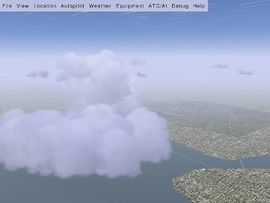3D clouds

FlightGears weather system uses 3D clouds for a realistic reproduction of the sky. 3D clouds have been present since version 0.9.1, and significantly updated in version 0.9.9.
When FlightGear switched from PLIB to OSG the 3D clouds were temporarily lost. Currently efforts are going on to re-implement the clouds. As of October 2008 the clouds are back and committed to FlightGear CVS, and released with FlightGear 1.9.0 that December.
Cloud shapes and layers
A 3D cloud layer is defined in the <layers> section. It contains of a number of randomly located <boxes>, containing a set of <clouds>.
Each cloud is generate with random size, based on the following tags:
<min-cloud-width-m> <max-cloud-width-m> <min-cloud-height-m> <max-cloud-height-m>
The cloud consists of <num-sprites> individual sprites. Each sprite is generated with random size, based on the following tags:
<min-sprite-width-m> <max-sprite-width-m> <min-sprite-height-m> <max-sprite-height-m>
The <texture> defines the texture file to be used for the sprite. The texture file may contain more than one texture in a grid, by setting the <num-textures-x> and <num-textures-y> tags.
Cloud are darker towards the bottom. bottom-shade indicates the shading factor of the bottom of the cloud compared with the top.
